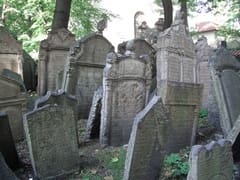Prague is known as one of the most beautiful cities in the world and has been a center of culture, commerce and politics for hundreds of years. Many nationalities have influenced her history, most notably German, Italian, Flemish, and Bohemian, as reflected in the architecture. Romanesque, Gothic, Renaissance, and Baroque mix with cubist and art-nouveau buildings, but the old world charms prevails as arched stone bridges cross over the fog laden River to connect the cobblestone streets of the “City of a Hundred Spires”.
The city is laid out over seven hills dissected by the Vltava river and sewn back together with twelve bridges. The oldest and most spectacular of these is Karluv Most, commonly called The Charles Bridge, which only allows pedestrian traffic. Prague has many magnificent views, but be sure to ride the funicular up Petrin Hill for a spectacular panoramic vista.

One of the most intriguing sights to see in Prague is the Old Jewish Cemetery. It dates back to at least the 15th century and its predecessor, the Jewish Garden, possibly over 1000 years old. Aside from age, this cemetery is fascinating because Jewish law does not allow destruction of graves, so when the available space was full, they removed the tombstones, added layers of soil, and then replaced the tombstones. There are now 12 layers of graves with over 12,000 tombstones crowded side by side into the same original space.
While the Czech Republic has over 2,000 preserved castles and chateaus, the largest in the world is the Prague Castle, a Baroque masterpiece whose construction began around 870 AD and is still in use. Today, the city owns the sprawling complex and surrounding gardens which houses 19th century Czech art collections and the St. Vitus Cathedral with its radiant stained-glass windows. You can walk through most of the castle without charge; however, guided walking tours are available.
Climentinum is a large complex of Baroque architecture, second in size only to the Prague Castle. Since its inception in the 11th century, it has served as a chapel, a Dominican monastery, a Jesuit college, an observatory, the Charles University, and since 1781 has been home to the National Library of over 400,000 volumes.
The Old Town Square has been the heart of Prague and a traditional marketplace since medieval times. Brightly colored buildings and cafés line the square and it is a hive of activity from morning until evening. It is also home to the famous Astronomical Clock with moving figures that delights onlookers every hour. Another famous tower is the bell tower at the chapel at Loreta, a cloister and church that has been a pilgrimage destination since the first construction was blessed in 1631, and whose bells have rung out to the faithful since 1695.
Wenceslas Square has been a center for public gatherings for hundreds of years, including the 1989 Velvet Revolution bloodless citizens’ revolt that lead to the end of Communist rule in Eastern Europe. It is not truly a square, but rather a long commercial street lined with art-nouveau architecture. Although a vibrant area, it is best to walk during the day and not at night.
There are many other sights to discover in this beautiful and historic city. Be sure to take time to explore, discover, and wander off the beaten track in this glittering jewel of art and architecture known as Golden Prague.






I hope I’ll visit Prague soon, I’ve heard great things about the city.
Thx for all the interesint info 🙂
Thanks for your visit and comment. Please come again! – Beverly